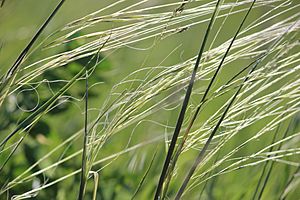Porcupine needlegrass facts for kids
Quick facts for kids Porcupine needlegrass |
|
|---|---|
 |
|
| Conservation status | |
| Scientific classification | |
| Genus: |
Hesperostipa
|
| Species: |
spartea
|
| Synonyms | |
|
Stipa spartea |
|
Hesperostipa spartea, also known as porcupine grass, is a type of grass. It gets its name because its long, sharp seeds look a bit like porcupine quills! This grass grows naturally across North America. You can find it from British Columbia to Ontario in Canada, and throughout the central and Great Lakes areas of the United States. It grows in clumps, which means it forms a dense group of grass stems.
Contents
Where Porcupine Grass Grows
Porcupine grass is native to the Great Plains and Canadian Prairies in North America. It also grows in the grasslands of the Rocky Mountains in both Western Canada and the Western United States.
This grass is very common. It is often one of the main grasses you will see in many prairie and grassland areas. For example, in Alberta, Canada, it often grows alongside another grass called rough fescue. In other places, it might grow with little bluestem grass. Porcupine grass can grow in many different stages of a habitat's development. It can be one of the first plants to grow in a new or disturbed area, or it can be a long-lasting part of an old, stable grassland. It can even grow well in poor soils and disturbed spots, like gopher mounds.
What Porcupine Grass Looks Like
This grass is a perennial plant, meaning it lives for more than two years. It grows in clumps and can reach over a metre (about 3 feet) tall. Its roots can grow very deep, sometimes as far as 1.8 metres (about 6 feet) into the soil!
The flowers of porcupine grass grow in a cluster called a panicle. Each seed has a very long, twisted "tail" called an awn. These awns can be up to 19 centimetres (about 7.5 inches) long. What's really cool is how these awns help the seeds. As the air gets drier or wetter, the awns twist and untwist. This movement actually drills the sharp seeds into the soil! This amazing process is called geocarpy.
Sometimes, several awns with seeds can get tangled together. The wind then blows this tangled mass away from the parent plant, spreading the seeds. The seeds can also stick to animals, which helps them travel to new places.
The seeds themselves are like tiny needles with sharp tips. Just behind the sharp tip, there's a ring of long, thick hairs that point backward. These hairs act like barbs, making sure the seeds stay in the soil once they've drilled in.
Porcupine Grass and Animals
This type of grass can be a bit tricky for animals like sheep. Its sharp seeds can get tangled in their wool while they are eating. Once caught, the seeds can sometimes work their way into the animal's skin.
Even though the seeds can be a problem, porcupine grass is generally good food for livestock, especially in the spring. It's also helpful in the fall because it stays green even when other grasses dry out. However, once the seeds are fully grown, their long, sharp awns make the grass less tasty for animals.
Growing Porcupine Grass
Porcupine grass is sometimes grown as an ornamental grass. This means people plant it in gardens because it looks nice. It's also used in projects to bring back native plant habitats, especially in the Great Plains.
How People Have Used Porcupine Grass
Long ago, Native Americans, like the Omaha and Pawnee tribes, used this plant. They would tie the awns (the long tails of the seeds) together. Then, they would burn off the sharp seeds at the ends to make brushes.



